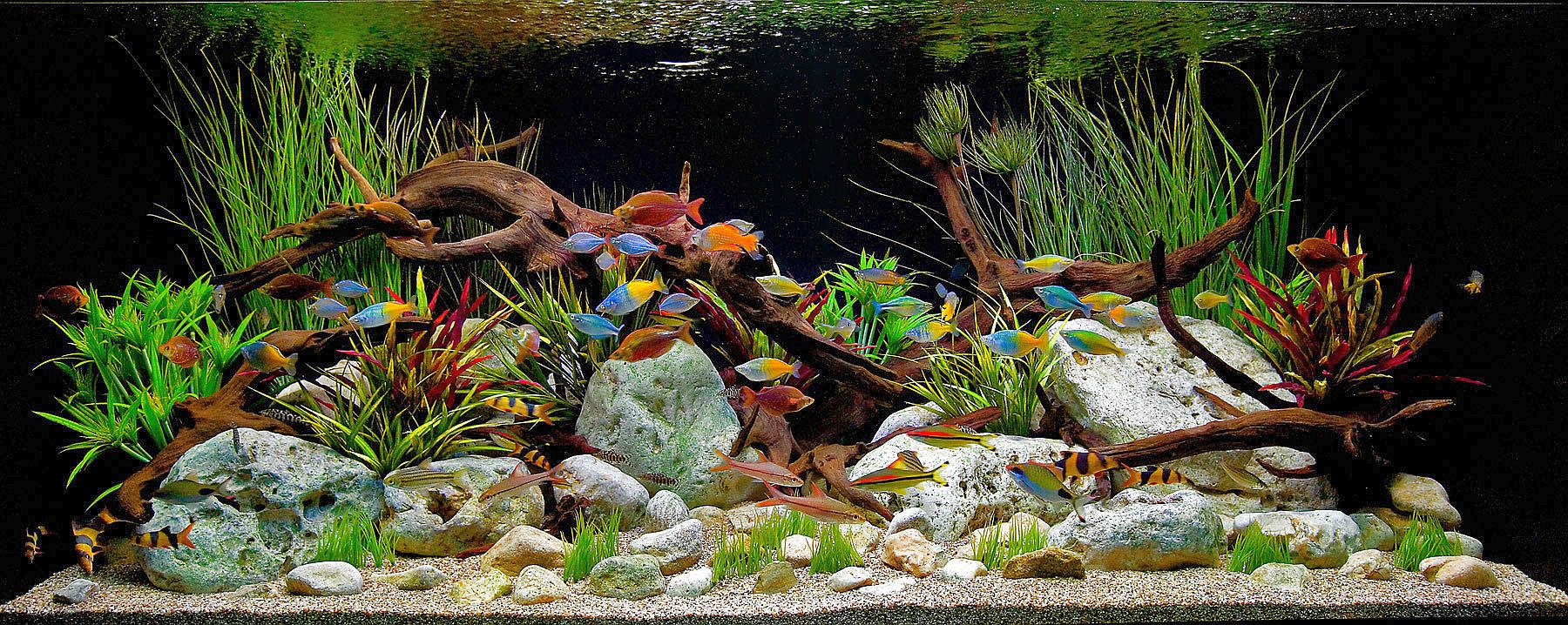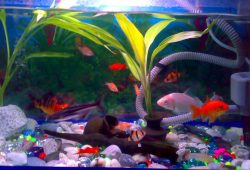Caring for Tropical Freshwater Aquariums
In the article I’ll tell you about Caring for Tropical Freshwater Aquariums. Proper setup and maintenance of a tropical freshwater aquarium is essential in order to keep the tank running efficiently and to help keep your fish healthy.

You must:
- avoid overstocking your tropical freshwater aquarium.
- avoid over-feeding your fish.
- observe your fish often, looking for signs of disease or illness.
- do periodic water changes.
- monitor the temperature of the tropical freshwater aquarium at least 1-2 times daily.
- monitor pH, ammonia and nitrite on a regular basis.
Contents
- 1 Stocking Your Tropical Freshwater Aquarium Properly
- 2 Avoid Overfeeding the Fish in Your Tropical Freshwater Aquarium
- 3 Periodic Water Changes for Your Tropical Freshwater Aquarium
- 4 Monitoring the Temperature of Your Tropical Freshwater Aquarium
- 5 Monitoring pH, Ammonia and Nitrite Levels in Your Tropical Freshwater Aquarium
Stocking Your Tropical Freshwater Aquarium Properly
When a tropical freshwater aquarium is overstocked, waste products such as ammonia and nitrite will build up in the water too rapidly. These waste products are a byproduct of the urine and feces of the fish entering the water as well as uneaten food spoiling on the bottom of the tank.
Normally, waste products produced in a healthy tropical freshwater aquarium are metabolized (used up) by bacteria which grow in the tank. These bacteria are beneficial to your aquarium and will not injure your fish.
Live aquatic plants can also be a big help in a tropical freshwater aquarium because the plants also help utilize the ammonia and lower the waste levels in the tank. The plants also give shy or frightened fish ample hiding places which reduces the amount of stress the fish experience and keeps them healthier. Planted tropical freshwater aquariums are often more stable and contain healthier, happier fish than non-planted aquariums.
The rule of thumb for aquariums containing small fish (guppies, mollies, platys, swordtails, etc) is that you should have no more than one inch of fish for each gallon of water in the tank. With larger fish, the rule to remember is that larger fish produce larger waste and need larger tanks.
Always know the adult size of any fish you purchase. Do not purchase a fish such as an arrowana or pacu which is expected to grow to a foot or more and expect it to live comfortably in a 20 gallon aquarium.
Avoid Overfeeding the Fish in Your Tropical Freshwater Aquarium
The most common mistake made by new fish-keepers is overfeeding. Fish need only small amounts of food to survive. Extra food will only serve to pollute their water and cause them harm.
Feed no more than your fish are able to eat in a five minute period and remove any uneaten food from your aquarium promptly.
Periodic Water Changes for Your Tropical Freshwater Aquarium
Periodic water changes are necessary to remove excess waste products from the water and prevent the tropical freshwater aquarium from becoming polluted.
Water changes are accomplished by removing part of the water from your tank and replacing it with an equal volume of new fresh water. Before adding the new fresh water to the tank, make certain that you have treated the water to remove any chlorine or chloramine present.
Changing small amounts of water frequently is preferable to changing large amounts of water on a less frequent basis. Water changes should be performed at least every 1-2 weeks, replacing approximately 1/4 of the water in the tank.
Monitoring the Temperature of Your Tropical Freshwater Aquarium
Ideally, the water in your tropical freshwater aquarium should be between 72-82 degrees (Fahrenheit). Check your aquarium’s water temperature often and adjust the heater as necessary
Monitoring pH, Ammonia and Nitrite Levels in Your Tropical Freshwater Aquarium
Ammonia and nitrite levels are indicators of the degree of pollution evident in your tank. A well-established tropical freshwater aquarium should have undetectable levels of both ammonia and nitrite.
pH is a measure of the acidity of the water in your tank. You should track the trends in the pH of your tank over time. pH levels will often start to decline if you are overfeeding your fish.
Measuring kits for ammonia, nitrite and pH are available in any pet store which carries fish products. You can also take a water sample to your local pet shop where they can test it for you.
If you notice that the ammonia or nitrite levels in your tropical freshwater aquarium are rising, you should immediately perform a water change. Also if you notice the pH starting to fall, you should do a water change immediately.
Lastly, don’t forget to sit back and enjoy your tank. That is why we establish these aquariums to begin with and the enjoyment is what makes the maintenance work worthwhile.



